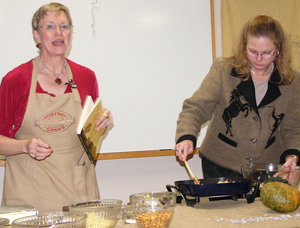Speaker says Lewis and Clark ate well in Midwest

One of the main reasons the Lewis and Clark expedition of 200 years ago was successful was because the explorers ate well, particularly while traveling in the Midwest, an audience at Chadron State College was told this week. The speaker, Mary Gunderson, practices palecuisineology, a word she coined to describe bringing history alive through cooking. She studies what people ate through the years and how they obtained and prepared their foods. Her web site is www.historycooks.com.
She said the Lewis and Clark party fared particularly well while traveling along the Missouri River in what is now the Dakotas. She said the entourage shot its first buffalo not far from where she lives at Yankton, S.D., and also dined on plum pie near there in August 1804.
“They ate as well as they could as often as they could,” Gunderson stated. “Some say they ate up to nine pounds a meat a day because the game was so plentiful. I believe it was more like from five to seven pounds a day, but their diaries indicate that they enjoyed the abundance that the prairie provided them.”
Gunderson, who was busy preparing foods for her listeners as she spoke, said buffalo was “the pinnacle of their culinary pleasures.” Some of the meat was smoked and salted, preserving it as what is now known as jerky. The explorers also ate everything from venison and elk to beaver during the trip. Fish were occasionally on the menu.
They also appreciated the wild fruits that they found in the late summer and fall, she reported.
As they continued up the river, Gunderson said Clark recorded in his diary that they traded an Indian chief some salt, sugar, beads and a looking glass (mirror) for about 10 bushels of corn, some beans and squash. The corn was soaked with ashes from the fires to convert it into hominy.
After reaching the area near what is now Mandan, N.D., where they spent the winter of 1804-05, Gunderson said Lewis and Clark supplemented their meat-heavy diet with squash and other vegetables that the Mandan and Hidatsa Indian women there had raised in gardens. Upon their return to that area a year later, Gunderson said the Mandans filled the explorers’ canoes so full of corn that they were afraid the crafts would sink.
The food was not as plentiful the farther west Lewis and Clark traveled, Gunderson said. Although the party was pleased to obtain horses from Shoshone Indians of Idaho after they could no longer travel by boats, the Shoshone homeland was not rich in wild game.
Chokecherries were a staple the Shoshone could count on, but Gunderson pointed out that was in sharp contrast to the buffalo and corn of the High Plains.
After crossing the Bitterroot Mountains into what is now Oregon, neither did the explorers find satisfaction with the Nez Perce’ root-based diet, the speaker said.
“When we learn what people ate years ago, it makes them seem closer to us,” said Gunderson. “Corn in many forms, buffalo, squash and other foods from that time are still available in our grocery stores.”
Gunderson, who came to Chadron State at the invitation of the Nekota Reading Council, has written several books blending history and recipes. One of the latest is “The Food Journal of Lewis & Clark: Recipes for an Expedition.”
Category: Campus News
